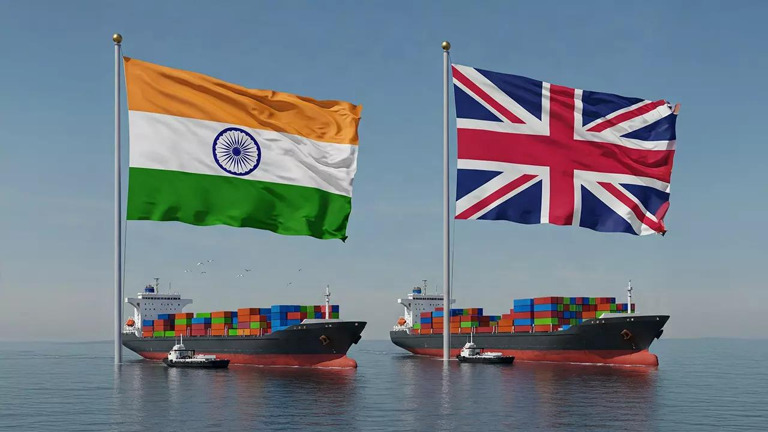On May 6th, the UK Prime Minister Keir Starmer and his Indian counterpart Narendra Modi had a call and announced that the UK and India had agreed a landmark Free Trade Agreement(FTA), along with starting negotiations for a Double Contribution Convention(DCC) which will come in force along with the wider trade deal. Both Prime Ministers hailed the deal as “historic” and this was the largest bilateral trade deal agreed by the UK at the time of the announcement.
The negotiations for this deal had begun in January 2022 under the government of Prime Minister Boris Johnson with an initial target to reach an agreement by November 2022. But due to changing governments, the deal took more than three years to be concluded. However, work is still continuing to finalise the legal text of the deal. Only after that is completed, the agreement will be ready for being signed. Once the agreement is signed, then ratification by both countries will be required after which the agreement will enter into force. So, in all, it could take at least another year for the agreement to enter into force.
According to the UK government, the agreement is expected to increase the UK GDP by £4.8 billion and UK wages by £2.2 billion each and every year in the long run. Bilateral trade is also expected to increase by £25.5 billion each and every year in the long run, £15.7 billion of which is expected to be from rising exports from UK businesses into India.
Some highlights of the deal:
- India agreed to slash duties on the vast majority of UK exports. Under the FTA, 90% of British tariff lines that cover roughly 92% of UK exports to India by value will see cuts or eliminations.
- The UK agreed to eliminate duties on almost all Indian exports. According to negotiators, 99% of Indian goods entering Britain will face zero tariffs. In particular, the UK will remove its remaining tariffs on textiles and apparel, a key export sector for India.
- Services trade is a core plank of the FTA. The UK secured “locked‑in” access to India’s fast-growing services sectors to give companies long-term certainty. Sectors relevant would include telecommunications, construction, engineering, and professional/business services.
- The agreement opens India’s large government procurement market estimated to be about £38 billion per year of tenders to UK firms. UK companies in transport, healthcare, life sciences and clean energy, for example, can now bid competitively for Indian government contracts.
- Both sides will pursue mutual recognition of professional qualifications – through an officials’ working group – to let accountants, architects, engineers, consultants and others more easily practice in each other’s markets.
- The FTA contains modern digital-commerce provisions. These include legal recognition of electronic contracts and signatures, commitments against forced localization of data or source code, and provisions to allow free cross-border data flows.
- The FTA includes a special arrangement for cars. India – the world’s third-largest auto market – offered separate tariff quotas to the UK for traditional internal-combustion vehicles and electric vehicles. Tariffs on cars meeting quota criteria will gradually fall to 10% over the phase-in period.
- A major positive for India is the removal of tariffs on UK imports of clothing, footwear and related goods. Indian apparel exporters, which constitute a labor-intensive sector will benefit from duty-free access to Britain.
- India protected its generics industry by excluding “data exclusivity” provisions that had been sought by the UK. In practical terms, UK pharmaceuticals will continue to face strong generic competition in India, as Indian laws still allow generic firms to rely on clinical trial data once patents expire.
- The agreement also strengthens intellectual property and regulatory collaboration. Copyright protections in India are guaranteed for at least 60 years, benefiting UK creative exports. Cooperation chapters cover competition policy, standards, and a new commitment to anti-corruption, labor rights, and gender equality standards. This will mark the first time India has included such social provisions in an FTA that it has signed.
No Extra Visas, But Easier Access: What the India-UK Trade Deal Means for Indian Workers
There had been some anticipation that the agreement would have provisions for extra visas for Indian workers which was one of the reasons for the delay in clinching the agreement. However, the final text doesn’t have any provision for any extra visas specifically for Indian workers. It does contain a provision allowing Indian independent professionals such as chefs, yoga teachers and musicians to access visas through the contractual services supplier’s route which they weren’t allowed to do before.
The contractual services suppliers’ route is a pathway for workers and self-employed people to stay in the UK for 6-12 months. They must be sponsored by a UK business and meet the required salary and skills requirements. The route is available for other countries that have trade agreements with the UK and is capped at a total of 1,800 visas a year. So, the UK-India trade agreement merely unlocks the option for Indians to apply as part of that route like other countries with trade agreements with the UK are able to do. There won’t be any separate quota for Indians in this route or in any other visa category.
There was an additional provision that while not strictly having to do with immigration, does have a relation to it. The provision will allow Indian workers are seconded to the UK on short-term visas by Indian employers, to claim exemption from National Insurance Contributions for both themselves and their employers for up to three years. They will make social security payments in India instead and this provision will work reciprocally for British workers in India who are seconded by British firms.
This provision came under a lot of criticism from Conservative and Reform party leaders. Leader of the Opposition, Kemi Badenoch made the following statement on X:
“This is two-tier taxes from two-tier Kier. I refused to sign this deal because:
- Tax refunds for Indians not available to us
- Visa requests too high
- Ceramics and Aluminium industries would be screwed.
Andrew is 100% correct.
When Labour negotiates Britain lose”
Reform party leader Nigel Farage said that
Keir Starmer had “sold out British workers to the highest degree”. Robert Jenrick, the Shadow Secretary of State for Justice, criticized the deal stating that the deal will allow Indian migrants to have an exemption for National Insurance while it is hiked on British workers. Suella Braverman, Conservative MP and former Home Secretary, claimed that as Home Secretary she had blocked the deal because she was not willing to grant any concessions on visas but Prime Minister Starmer had caved and opened the labour market to more Indian workers.
Beyond Politics: Understanding the Policy and Promise of the India-UK Free Trade Agreement
It’s unfortunate to see these developments as it was assumed that the India-UK Free Trade Agreement which should have had cross-partisan support considering that it was the Conservative Party government that started negotiations for this deal and was heavily promoting it while they were in power. But since our focus is on the policy aspects of this agreement and not on the politics, we would not delve more into the political ramifications of these developments.
To delve deeper into the policy of this provision, this is a standard Double Contribution Convention that is not unique to India as UK follows this convention with other countries such as Canada, Japan and the Republic of Korea and it’s a reciprocal agreement that gives equal treatment to both British and Indian workers working who are seconded to the other country by British and Indian firms respectively. This provision would not benefit any Indian worker in the UK who was working for any British firm or for any Indian firm as a long-term employee.
Prime Minister Starmer claimed that the deal helps his “Plan for Change” agenda of economic security, while industry ministers have highlighted the export and investment potential. Prime Minister Modi stated that India and the UK have “successfully concluded an ambitious and mutually beneficial free trade agreement” and that he was looking forward to welcoming Starmer to India soon for the signing of the agreement. Industry leaders praised the alignment of shared interests. The Federation of Indian Chambers of Commerce and Industry(FICCI)’s president called the agreement “a bridge to shared prosperity” that reflects India’s status as a global economic force. The CII (Confederation of Indian Industry) described it as a “transformative accord” deepening trade and technology cooperation.
Conclusion
To conclude, the India UK Free Trade Agreement is a landmark agreement for both countries. It systematically cuts tariffs and opens markets, from Scotch whisky to car parts, while committing to modern trade rules on services and digital commerce. This will boost businesses and commerce in both countries and will help capitalize on new opportunities. Both the governments have emphasized that this agreement will deepen an already growing partnership on several fronts including trade, innovation and global influence.


